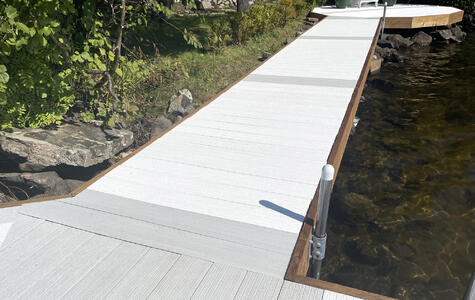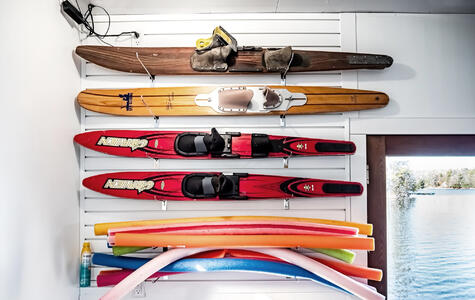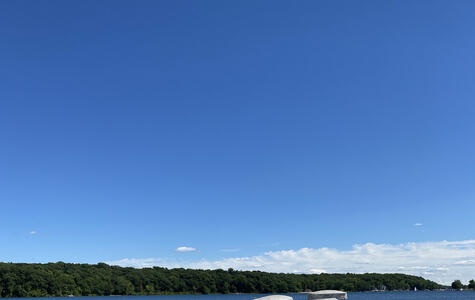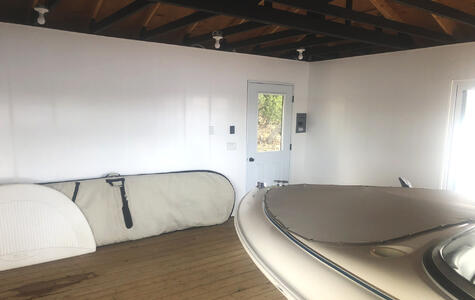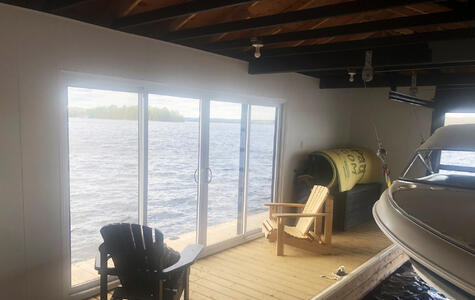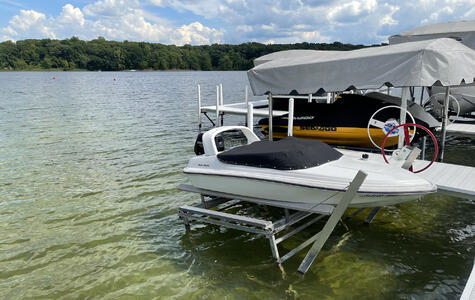Building a dock is a complicated process that requires a lot of planning, a good knowledge of local geography and the body of water you’re building a dock in, and specialized construction skills. And that’s all before you determine the type of dock you need to build or select the material you want to build it with.
As a result, there’s no one-size-fits-all answer to how to build a dock, but there are lots of things to consider before you hire a contractor to do it for you.
In this blog post, we explain:
- The difference between a floating and fixed dock
- The special environmental factors that affect which type of dock you can build
- The pros and cons of the most popular dock decking materials on the market

What is the Difference Between a Fixed and Floating Dock?
For private docks of cottage or cabin owners, there are two popular types of docks: fixed and floating.
A fixed dock or a stationary dock is firmly attached to the bottom of whatever body of water your dock is in. These docks are typically built out of wood or concrete and are built at a fixed height. It’s common for fixed dock owners to add gazeboes and other amenities to the structures since they're so sturdy.
A floating dock, on the other hand, is secured to the land and doesn’t have a framework that sinks down to connect it to the bottom of the body of water. A floating dock uses steel tubes, barrels, and air chambers to float on fluctuating water.
What Environmental Factors Do I Need to Consider When Building a Dock?
The type of dock you choose to build, whether fixed or floating, will depend on several environmental and geographic factors:
- Water Depth. If the water line in the lake or river you’re building a dock in is over four feet high, a floating dock is ideal. If the water is less than four feet deep, then a fixed dock is your best choice. In water that’s less than four feet deep, a floating dock can get close to the bottom of the body of water and be punctured.
- Water Fluctuations. Water level fluctuations will also affect whether you build a fixed or floating dock. If the water levels fluctuate often, a floating dock is best because it will stay with the water level, making it easy to move from the dock to your boat and back.
- Local Weather. If you live in an area that’s prone to hurricanes, thunderstorms, high winds, or flooding, a floating dock is the right choice. When bad weather hits, the wind and waves can cause your boat to move back and forth. A floating dock moves with water and the boat, while a fixed dock stays in place. The boat can crash into the dock, damaging it. Bad weather and significant rain can also cause water levels to rise, submerging and damaging a fixed dock.
- Boat Traffic. If you live on a busy body of water with lots of boat traffic, you can expect lots of waves heading your way. Since floating docks move with the water, it’s best suited to busy waterways. If you live on a quaint and quiet lake, a fixed dock is a good investment.
- Floor Conditions. The floor conditions of a body of water can vary significantly even along the same shoreline. In lakes, rivers, ponds, and the ocean, you can find sand, mud, silt, rock, clay, and vegetation. What you find will affect the type of dock you can build: Sand, silt, and mud can’t support the pilings or pipes of a fixed dock and are better suited for floating docks, while clay and rock bottoms are compatible with fixed and firm docks.
When it’s time to hire a contractor to build your dock, go local — a local contractor will likely be familiar with the water conditions and can build a dock that will meet your needs and last a long time.
Contractor Spotlight: Building a Dock on Sunfish Lake in Ontario, Canada
Jim Boshart, principal of Boshart Construction, is an expert in dock construction. Boshart has now completed seven docks for home and cottage owners on Sunfish Lake, just a few minutes’ drive northwest of Waterloo, Ontario. He has been hired to build another three docks on the same lake.
How to build a boat dock? The process, he says, starts with a plan, and the plan must be tailored to the particulars of the lake for which the dock is intended.
“All docks are different,” he says. “What’s unique about Sunfish Lake is it’s small, but it’s quite deep – about 66 feet – and the bottom of the lake is all mud and peat. It’s just muck on the bottom.”
The sharp drop-off and the soft bottom at Sunfish Lake dictated that a pier dock, also known as a pile dock, be Boshart’s dock type of choice.
A pier dock is a fixed dock supported by large posts driven into the bottom of the waterbed. A pier dock is stable, strong, and able to withstand plenty of severe weather – not that particularly severe weather is an issue at Sunfish Lake. But what is an issue is the soft lake bottom. Boshart’s piers are driven down deep enough into the lakebed that they find firmer footing, ensuring they, and the dock that they’ll support, will remain stable.
“The piers are driven down anywhere from 11-to-15 feet,” Boshart explains. “My posts are spaced about four to five apart,” ensuring plenty of support for the structure.
Another reason a pier dock works well for Sunfish Lake is that the lake level is reasonably constant, meaning there’s a low risk of the dock being swamped by the lake or left too high above the lake level; on lakes where the level fluxgates widely, a floating dock might have been a logical choice.
Which Dock Decking Material is the Best to Build With?
Dock decking can be made from a variety of materials, but which you choose to build with depends on the type of performance you’re looking for:
- Wood. Pressure treated wood is a popular dock decking option because it’s cost-effective and available everywhere. However, any type of wood is prone to splintering, rotting, and warping over time. As a result, wood docks need a lot of maintenance and are likely to need replacing despite your best efforts. You’ll also need to be sure that any treated wood you buy is safe for use in a lake or pond – some pressure treated wood can release harmful toxins into the water when damaged.
- Composite. Composite dock decking is a blend of wood fiber, polypropylene, polyethylene, and crushed minerals bonded together using adhesives. Composite decking is available in different colors and textures, lasts longer than wood, and is largely maintenance-free. However, if organic material is used in composite decking, it can be susceptible to mold and mildew which can cause the decking material to degrade or decay.
- Metal. Aluminum and steel are the popular metals for docks. Aluminum is more expensive than wood but requires less maintenance. Aluminum also won’t splinter or rot, and it’s less prone to corrosion than steel. Steel docks are stronger and won’t warp from harsh waves but is heavier and harder to install. You can expect that both metals will get very hot in the summer sun and in high temperatures, which isn’t ideal if you plan to be without shoes or sandals on your dock at all.
- PVC. Plastic dock decking can be made from polypropylene, polyethylene, or polyvinyl chloride (PVC). Unlike composite, PVC dock decking like DockDeck by Trusscore is moisture and water resistant, so it won’t grow mold or mildew, and it’s lightweight, durable, and easy to keep clean. In hot weather, it will remain cool to the touch, and it will never rot or splinter. Like composite, PVC decking is manufactured in a variety of colors and textures.
Once you consider the type of dock that’s best suited for the water around your cottage or cabin and the materials you’d like to build it with, you’re ready to hire a contractor to kickstart your project.
Products for Docks
DockDeck
DockDeck by Trusscore is a high-performing and sustainable alternative to composite decking, pressure treated wood, and aluminum that will look its best for decades to come.
En savoir plus




